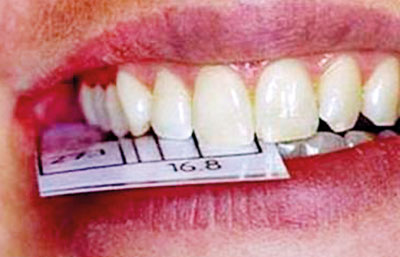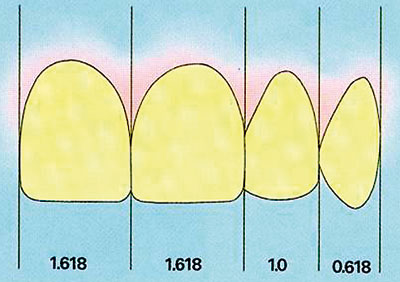Dental surgery to the fore
Consultant Oral and Maxillo-facial Surgeon, Dr. Suresh Shanmuganathan discusses trauma and oral cancer
Any defect, disease or injury to the mouth, the jaws or the face, it will be the Oral and Maxillo-facial Surgeons who will step in to put it right. Tackling two of the major issues affecting the facial region, Consultant Oral and Maxillo-facial Surgeon, Dr. Suresh Shanmuganathan who is also President of the Sri Lanka Dental Association says they are trauma and oral cancer. Trauma, he says, could be due to road traffic accidents or assaults, which are both preventable. Trauma could range from a tooth fracturing orcoming out to the facial bones getting injured.

The Greeks came up with the "Golden Proportion' for beautiful things and Dr. Shanmuganathan says that the ratio for a radiant smile is 1.1618:1
If a tooth comes out, according to him, it should be put into a container with milk or even kept in the saliva collecting in the victim’s mouth itself. The most important thing is to come to hospital within one hour, as then the tooth can be put back into its socket and a splint (wire) attached.
If brought within the hour, there is a 90% chance of survival, MediScene learns. The more the delay, the higher the risk of the tooth resorbing.
A major but common injuries in road accidents or assaults is cheek-bone fracture and displacement. “Then we have to open up and fix the fracture,” says Dr. Shanmuganathan, explaining that if involved in a high-speed vehicle accident there could also be fractures of both the upper and lower jaws, along with head injuries.
In the past we would wire the jaws together, he says, pointing out that then the victim would not be able to open the jaws for three to four weeks and would have to be on a liquid diet. Now, however, treatment has advanced to such an extent that the fracture lines would be set with mini-plates made of ……..enabling the opening of the jaws. There is better bone-alignment and, in turn, a better cosmetic effect.
When the face is involved, people worry about scars after treatment and we identify the natural lines of the face for the incisions, leaving minimal scarring, he says, while the plates are also re-absorbable, the limiting factor though being the high cost. In the case of complex fractures involving the frontal bones, this Oral Maxillo-facial Surgeon says that they approach the injury from the scalp, peeling the scalp and then plating the fracture.

Moving onto the other category, Dr. Shanmuganathan says that nearly 1 in three among cancer patients has oral cancer in Sri Lanka.
Disclosing some disturbing statistics, he says that of all the cancers prevalent in Sri Lanka, oral cancer amounts to 30%, with a higher incidence among men than women.
The causes are easily preventable, according to Dr. Shanmuganathan, pointing a finger at betel chewing. Going into specifics, he says that although the betel leaf is not harmful, the tobacco, arecanut and chunam (lime) is a lethal cocktail. The tobacco in cigarettes and also beedis are equally harmful.
Lamenting that oral cancer is mainly a disease of the poor, he says that it is easily identifiable, but in Sri Lanka the patients come very late only when there is severe pain. This leads to much misery not only to the patient but also the care-givers and doctors who struggle to treat them.
In the past, MediScene learns, oral cancer affected the cheeks but now more and more cases of cancer affecting the tongue and floor of the mouth are seen. “This may due to changes in habit. The victims may be also consuming alcohol in addition to chewing betel and the lethal cocktail may be moving around the mouth and seeping through the thin mucosa, affecting the tongue as well as the lymph nodes of the neck,” he says.
In the past, MediScene learns, in such instances the jaw would be removed and a flap from the forehead inserted there, but it would present a bad cosmetic effect. Now, says Dr. Shanmuganathan, explaining that they use the “free flap surgery” depending on the tissue affected. “We take a flap from the forearm along with the blood vessels and insert it into the floor of the mouth, connecting the blood vessels to those in the neck.
He cites the other sites from which harvests would be made, depending on the need, such as bone from the hip with the blood vessels, all of which would enable the Oral Maxillo-facial Surgeon to reconstruct the whole face without any cosmetic defects. The other important factor is that the functioning would also not be impaired.
Conceding that “it is no easy job”, he says that such surgery which includes 12-14 hours theatre work, is a heavy burden on the government, costing “big money”, around Rs. 1 million. There would be an additional cost if chemo and radio therapy have to be given.
This is why he urges prevention by not resorting to the tobacco habit and coming in early for treatment.
International dental sessions
The Joint International Conference and 80th Anniversary Annual Scientific Sessions of the Sri Lanka Dental Association will be held from June 27 to July 1 at the BMICH in Colombo. More than 1,000 delegates, both foreign and local, will attend the sessions which are being organised in collaboration with the FDI World Dental Federation and the Commonwealth Dental Association.
MediScene is the print media sponsor of the sessions.
Then there were ‘pullers’, ‘fillers’
Not only did they cut your hair and shave you but they also did what had to be done to your teeth. Yes, in ancient times, barbers doubled up as ‘dentists’, smiles Dr. Shanmuganathan, explaining that it had all to do with the chair. The current chair that Dental Surgeons use is modelled on the humble chair that barbers used, which in those days gave them access to hair and beard as well as the mouths of people, making the task of pulling out teeth easy, according to him.
Dentistry’s early roots lie in Egyptian times when it was a ‘family business’ passed down from father to son. It evolved into a science in the 16th century, MediScene learns, but even then as anaesthesia was not known, whoever was having tooth trouble was held down firmly while the dentist pulled out the offender.
In those times, dentists were just ‘pullers’, ‘fillers’ and ‘cleaners’, says Dr. Shanmuganathan, pointing out that in different parts of the world there would be different interpretations with regard to work done on teeth. A diamond on a tooth would mean prosperity.
Gradually, as demands grew with regard to the teeth work requested, dentistry as a science also developed. While the condition of the teeth matters, now more people are also seeking aesthetic dentistry which includes the face as well, he says.
This led to dentistry branching into several sub-specialities and becoming a state-of-the-art science.
Follow @timesonlinelk
comments powered by Disqus


